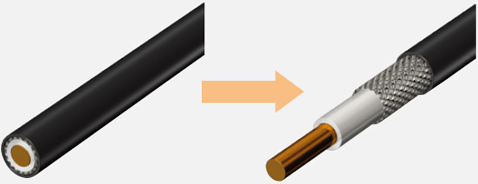Laser cutting – Elena
This section presents laser cutting based on laser processing through examples.
Basic principles of cutting using laser markers
Laser cutting involves cutting and evaporating the surface of a material using a laser.
Generally, non-laser cutting involves the use of a die or a knife. Because these are contact type methods, there is always the risk of distortion that occurs during processing. On the other hand, laser cutting is contactless, so the risk of distortion or something similar is minimal. This makes laser cutting suitable for the processing of objects such as plates and thin films.
Example of laser cutting – Laser cutting of electrical wire coating
Application Explanation
Conventional methods for cutting the electrical cable sheath involve a contact type cut with a blade. Such methods are difficult to adjust and carry the risk of damaging the central cable.In addition, in order to maintain their edges, we usually need to change the cutting blades regularly, which increases operating costs.
Because the metal just can reflects CO2 lasers but not can absorbs. There is no need to worry about accidentally cutting the central cable. The ability to reliably cut only the outer film means less defective objects and better quality.

When a coaxial cable is processed, the coating is cut with a CO2 laser, which is not absorbed by the metal; while the inner and outer conductors of microfabricated metal cuts with an ideal YVO4 laser. In this way, simultaneous processing is possible, taking advantage of the various characteristics of each laser.
In addition, the use of a mirror-finished surface, such as an SUS material, allows the laser light can cut both the back and the front of the power cord at the same time. Allows the front and back processing in a single step, which dramatically reduces the processing time and allows for greater production efficiency.
Basic principles of engraving with laser markers.
The ability to flexibly change the power and speed of scanning a laser, allows cuts, incisions or grooves in an object, at different depths. The following example of label processing uses a low laser power for marking, and a high laser power around the marking for shallow cuts.
Engraving example – Creating perforations in films
Application Explanation
One of the best examples of surface cutting are perforations made in bags and other products to facilitate hand tearing. Conventional methods include the use of a cutting blade to make shallow cuts, but this presents several problems, such as difficulties with adjustments and the time needed to change the configuration between various types of products. This method also requires that the blade be replaced periodically, which increases operating costs, and there is always a risk that the blade will break in the bag.
Advantages of laser processing
The lack of consumable components helps reduce costs and improve productivity.
Achieve significant reductions in current costs by using non-contact laser processing. Thanks to the elimination of maintenance and replacement of worn parts, required by conventional methods. In addition, as the parts do not wear out. Nor is the quality of the processing adversely affected, stable operation can be guaranteed, making it possible to improve productivity.
Support for different product sizes and 3D shapes
The use of a 3D laser marker allows you to set the optimal focal length anywhere, up to 42 mm. This eliminates the need to focus using lifting equipment for the marking head or the use of templates for each type of object. This not only contributes greatly to reduce the installation costs, but also reduces the time spent on changes.
more detail please click: www.xtlaser.com



